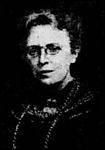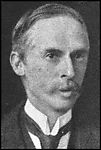 Clementina Black, champion of women's issues, spoke in favour of a minimum wage at the National Conference of Trade Unionists in 1906
Clementina Black, champion of women's issues, spoke in favour of a minimum wage at the National Conference of Trade Unionists in 1906 J. A. Hobson, economist and author, supporter of the minimum wage and speaker at the Conference.
J. A. Hobson, economist and author, supporter of the minimum wage and speaker at the Conference.

The National Anti-Sweating League was a powerful pressure group set up following the first Sweated Industries Exhibition in London in 1906. J.J. Mallon was its secretary. Mary Macarthur, Sidney Webb and many other influential people served on its committee. It campaigned to rid the country of sweated labour. Its members believed the only way to do this was to pass laws to set a minimum wage.
The League played an important role in bringing the conditions of sweated workers to the attention of the public. Continuing the success of the London exhibition, they organised large scale exhibitions in major towns all round the country. After each one, a local branch of the Anti-Sweating League was formed.
The League also saw the importance of gaining the support of the labour movement. They put their proposals to a national conference of trade unionists. The conference took place in October 1906 at the Guildhall in London. Three hundred and forty-one delegates were there, representing two million organised workers. They listened to lectures by experts on the subject, including Clementina Black, a champion of women's issues, and J.A. Hobson economist and author.
Pressure on the Government grew. A commissioner, Ernest Aves, was set to Victoria in Australia to study the wage boards that had been set up there in 1896. In 1907, a Select Committee of the House of Commons on Homework, (paid work carried out in a domestic setting), was appointed. Mary Macarthur was one of the people called to give evidence. The committee members were so impressed with what she had to say, that they asked to see some of the sweated workers on whose behalf she spoke.
Mary reinforced what the women had to say to the committee with an experience of her own. Mary had often been struck by the number of baby outfits families offered for sale in the newspaper. She sent for one and traced where it had been made. This took her to one of the worst slums in London. Here she found a young girl making little lace trimmed baby clothes, at a rate of one penny each. The girl was developing diphtheria. She was poor and had no bedclothes, and so she used the linen she was working with to cover herself. After handling the cloth, Mary herself caught diphtheria and was in hospital for six weeks. The story vividly demonstrated the horror of sweated labour. "When they saw it as setting death in the folds of a baby's robe, they shuddered." (Hamilton, 1925, p.80)
Reporting in 1908 the Select Committee decided that the only way to stop sweated labour was to pass a law that set a minimum wage. The Trade Boards Act was passed in 1909.
Rollover the captions in the box to see the available images in thumbnail format, click the caption to see the full-size image
| Reference: | 720 |
| Keywords: | |
| Archive Ref: | |
| Updated: | Thu 12 Jul 2007 - 1 |
| Interpretation written by | Barbara Harris |
| Author's organisation | |
| Organisation's website |